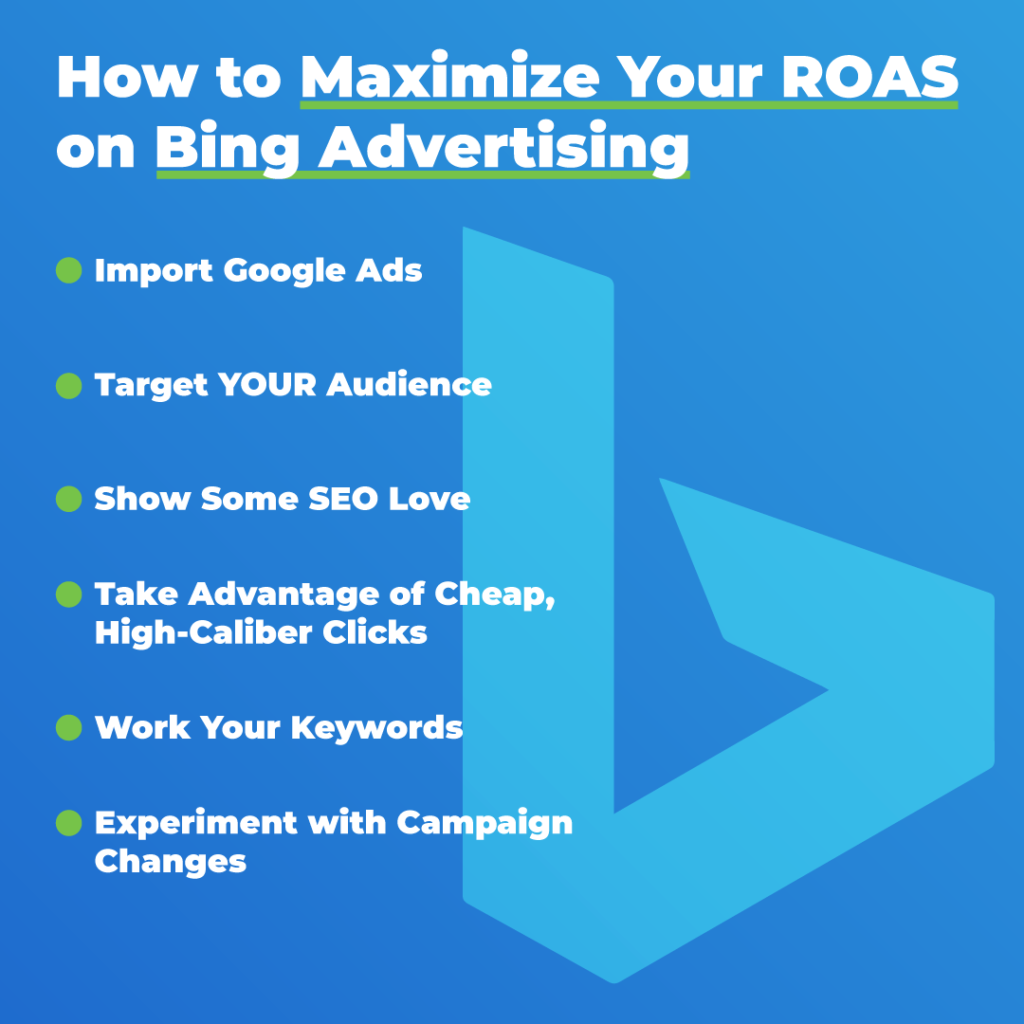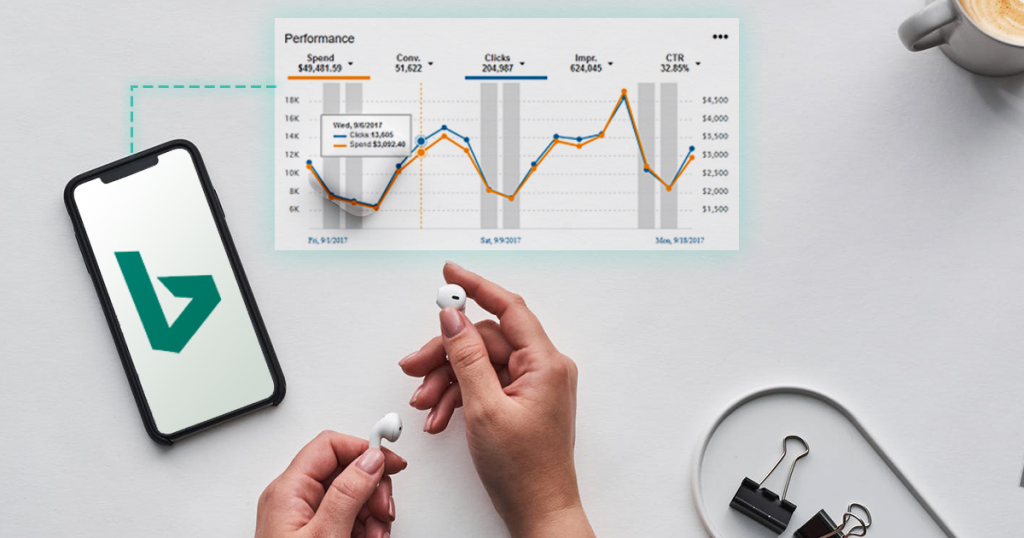If you are a digital marketer who isn’t targeting Bing advertising, it would be wise to consider revamping your strategy to include a Bing campaign strategy. While Google may be the dominating search engine giant, Microsoft Bing is a growing platform that now clocks in second behind Google for all laptop and desktop searches.
That means Bing is a significant search engine rivaling Google, and your potential customers are likely using it.
If you are new to Bing and unsure how advertising on the platform works, read on to understand how to make the most out of Bing advertising to increase your reach and maximize your ROAS.
What Is Bing Advertising?
Microsoft (Bing) advertising, like Google Ads, allows digital marketers to display pay-per-click (PPC) ads across the search network to reach their audience, boost traffic, and increase revenue. One major benefit of this advertising platform is that Yahoo! and Bing are powered together, meaning your Bing ads are seen on Bing, Yahoo, and AOL.
While Google AdWords is more widely known and currently sits on the search engine throne, Bing is larger than you think – the search engine accounts for 33% of internet searches. You might be overlooking one-third of your audience if you aren’t optimizing for Bing.
As a marketer, it’s up to you to show up and find your people no matter what corner of the internet they’re occupying. Bing advertising has the potential to reach millions of people, including key parts of your target audience.
Is Bing Advertising Even Worth It?
Bing advertising has some significant advantages over Google AdWords. For one, ads are often cheaper on Bing, so you won’t burn through your ad budget as quickly as you would on Google Ads. You’ll be able to find keywords at a lower cost-per-click with higher click-through-rates, which is a major win for any advertiser.
Diversifying your advertising reach is also a smart move to ensure you’re not at the whim of one platform, so it’s definitely worth expanding beyond Google. Bing can open up your ad campaign to a wider audience while preventing you from being at the mercy of Google’s trends, decisions, and pricing.
Exploring Bing advertising is a savvy way to kick off a new, successful ad campaign. Maximizing your return on ad spend (ROAS) depends on the strategies you employ, so let’s talk about that next.
How to Maximize Your ROAS on Bing Advertising
First, we’ll let you in on a time-saving secret: an incredibly useful feature of Bing advertising is the ability to import the Google Ads campaign you (may) already have set up. Instead of recreating your campaign, you can easily expand your advertising reach to Bing audiences with just a few clicks.
Whether you import an existing campaign or start from scratch, maximizing your ROAS on Bing advertising requires knowing and leveraging the platform’s unique advantages, including the unique characteristics of Bing users.
It’s important to note that Bing has a different audience than Google, so your AdWords campaign may not be optimal for Bing advertising. Make sure you know the behaviors and needs of your searchers so that your campaign is tailored correctly no matter which platform you use. Luckily, Bing user characteristics can give you a good idea of whether a Bing campaign will be an effective strategy for you.

Target Your Audience
You can leverage Bing user demographics to target your advertising campaign to the ideal audience. Since 85% of Bing users are from within the U.S., focusing on U.S. customers is a smart move. Another notable trait of Bing-ers (when this term catches fire, remember that we coined it) is that 87% of Bing searches come from people using Internet Explorer as their default browser. The stats for Internet Explorer users tell us that they are:
1) less tech-savvy than users of other browsers;
2) typically over 35 years old; and
3) one-third have a household income of $100,000.
You can extrapolate more Bing user characteristics from this data to further target your audience. For example, if Bing users are mostly over 35 years of age, it stands to reason that they are more likely to have children (than, say, if users were in a younger demographic).
Buyer personas represent your ideal customers based on research and data, and knowing these user traits is helpful for you to discern whether Bing is a good advertising option for your product or service. Developing a buyer persona(s) helps you focus your time on the right prospects and overall provides an in-depth understanding of your customers so you can effectively reach and attract high-value leads.
The takeaway is to make sure you know the behaviors and needs of your searchers so that your campaign is tailored correctly no matter which platform you use.
SEO Love
Bing likes SEO, and so does your business.
Your business’s searchability and visibility is contingent upon how well you use SEO, and Bing Ads boasts a plethora of helpful guidelines, tools, and diagnostics to understand their algorithm and optimize your SEO efforts.
Bing’s Webmaster Guidelines detail how Bing finds, indexes, and ranks websites, and Webmaster Tools includes impressive features including SEO reports to improve your site’s ranking and an analyzer tool so you can analyze keywords, backlinks, and more.
Take advantage of Bing’s SEO love to better expose your business to the people searching for it.
Take Advantage of Cheap, High-Caliber Clicks
Clicks are cheaper on Bing – ReportGarden found that the cost-per-click on Bing Ads averages $7.99 compared to $20.08 on Google AdWords.
It’s safe to assume you have a smaller amount of money to spend on Bing Ads than Google AdWords, so cheaper clicks are a budget advantage. But cheap clicks don’t necessarily mean good clicks – a successful advertising campaign drives high-quality traffic to your business, so we need to know whether Bing’s cheap clicks are a worthwhile investment.
Digital business builder Matthew Woodward did some data digging and found that Bing traffic has a lower bounce rate, clicks more affiliate links, spends more time on a site, and has more subscribers. Bing advertising for the win.
Work Your Keywords
Brian Dean of SEO training site Backlinko once had a website bring in 60,000 visitors per month from organic search. With that number of visitors, you’d think that site made him a good chunk of money, right?
Wrong. The site brought in just $400 each month. 60,000 visitors culminating in… $400. Yikes.
Instead of selecting your keywords for search volume, focus on keywords that draw buyers with intent. According to Backlinko, there are four classes of keywords:
1) Buy Now Keywords
2) Product Keywords
3) Informational Keywords
4) Tire Kicker Keywords
Buy Now Keywords are the keywords people search when their wallet is out and ready to purchase – think words like “Deal,” “Buy,” or “Shipping.” You might not get 60,000 visitors coming to your site, but the visitors that do come are the ones you want!
Product keywords focus on words like “Comparison,” or “Review,” or your specific brand name, service, or product category. They don’t convert as well as Buy Now Keywords, but using these keywords helps catch people earlier in the buying cycle.
Informational keywords are your how-tos. These are used by people searching for knowledge and awareness about a product or service they need, so use words like “Tips,” “Tutorial,” or “How do I” to direct searchers to the answers they’re looking for.
Tire Kicker Keywords are not for instant gratification. These searchers are likely not looking to make a purchase right now (they’re using keywords like “Free”), but at least their search intent is refreshingly transparent!
For a successful campaign using Bing advertising, work your keywords using the above four classes. Attracting the right customers is more effective than aiming for high search volume with no pay-off.
Experiment with Campaign Changes
You can do all the right research and preparation for your Bing (or any) advertising campaign but you won’t find out what works until you put it out there and see what happens.
Bing advertising allows you to run experiments to test and monitor the effectiveness of changes to your campaign before fully launching them across your whole campaign. This a fantastic feature to test
your ad copy, landing page URLs, and bidding strategy and modifiers.
Running an experiment campaign alongside your original campaign is a smart move to gather intel without wasting time or resources before making changes.
Conclusion
Google may currently be the search engine giant, but Bing is the sleeping giant worth watching (and using).
Tapping into Bing advertising could be an effective move for your business. You can never be certain before you try, however, so it’s critical to first set up a smart campaign using the above techniques. Maximizing your ROAS using Bing advertising takes knowing and targeting your unique Bing audience, taking advantage of Bing’s SEO tools and cheaper cost-per-click, using the best keywords to reach buyers, and experimenting with campaign changes.
Bing advertising is a great way to extend your reach beyond Google, find untapped potential, and bolster your campaign, all while not draining your ad budget.
And if you’re on Google Ads and looking for ways to make sure you don’t drain your ad budget with invalid traffic, make sure to check out ClickGUARD and what we have to offer. Pretty neat things, by the way. Just sayin’ 😉



